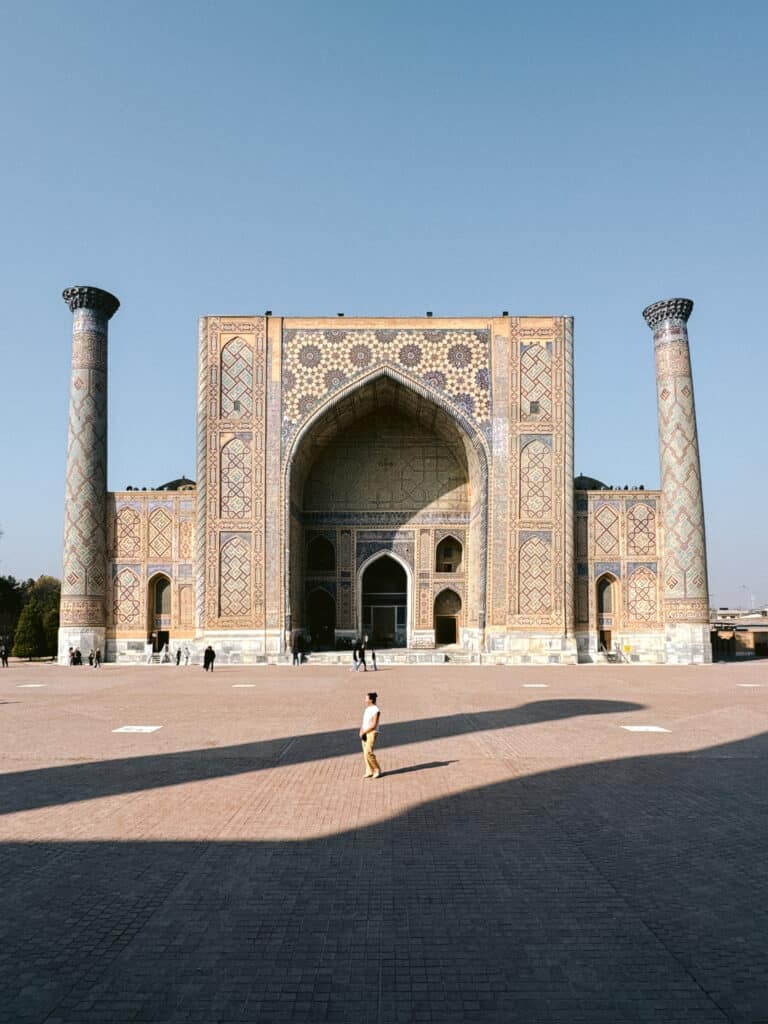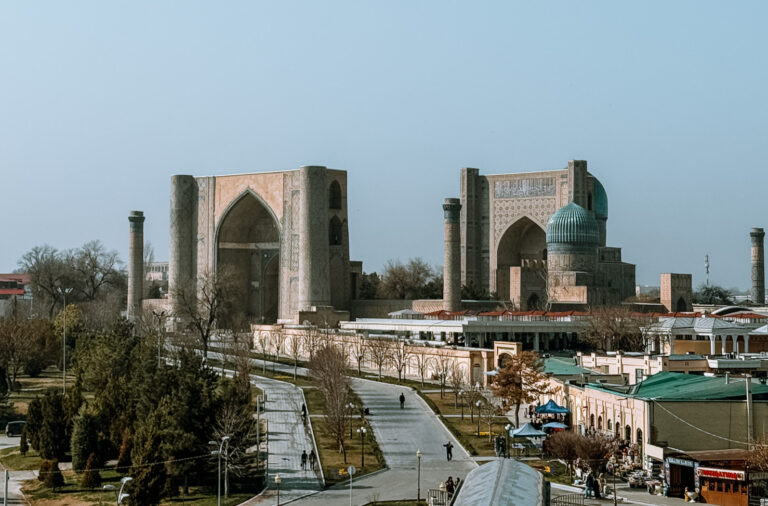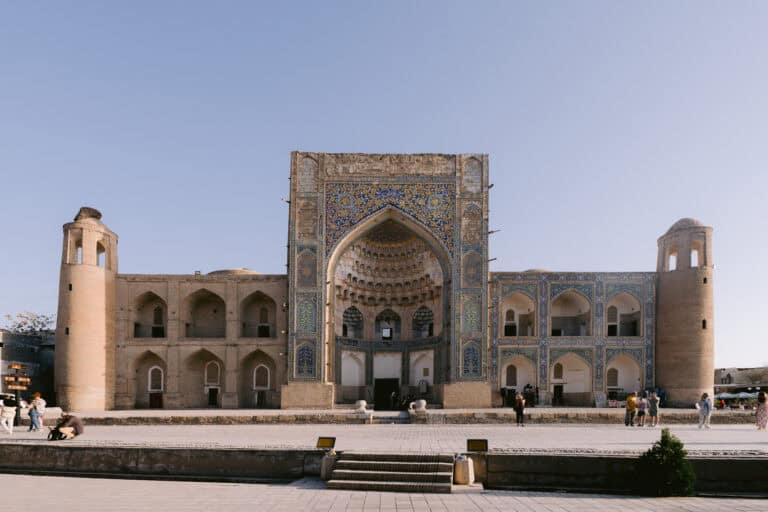Things to Do in Khiva: Uzbekistan’s Fairytale Walled City
Ahh Khiva, Uzbekistan — where do I start with you? I could write a love letter to this charming walled Silk Road city. Once a key stop along the ancient Silk Road, Khiva is a UNESCO-listed old town known for its blue-tiled minarets, desert walls, and maze-like alleys. While a bit out of the way to get to on standard Uzbekistan tourist itineraries, Khiva is worth the trek — if you do it right. I’ve been to over 100 countries, and Khiva was unlike any I’ve seen to date and one I highly recommend as part of things you must do in Uzbekistan overall.
If you’re not sure whether Khiva belongs on your Uzbekistan itinerary, what to do there, or how to plan your day — you’ve come to the right place! I’ve written this guide to the best things to do in Khiva so it has the practical details you need to plan your trip, with a side of my gushing about Khiva sprinkled in because I want you to love it as much as I did.
Why Visit Khiva
The question shouldn’t be “why visit Khiva” — it should be why isn’t Khiva topping the “must-see” travel bucket lists already especially since the world is slowly catching on to the beauty of Uzbekistan? 😉
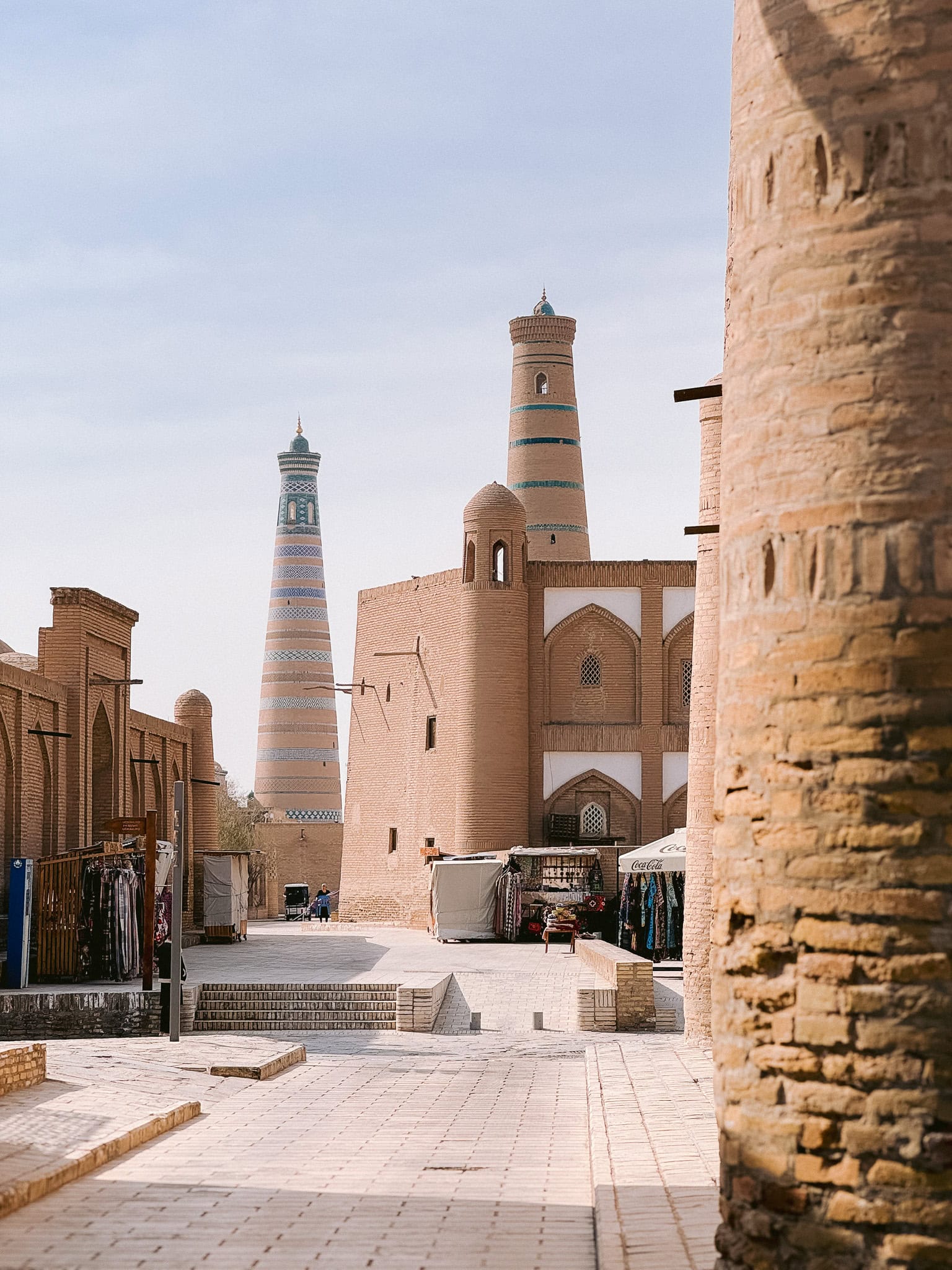
Khiva is magical. It has history. It’s in Uzbekistan’s Khorezm region, in the middle of the friggin’ desert. You step into its old walled town, Itchan Kala, a UNESCO World Heritage Site, and it feels like you’ve been transported back centuries to the time when the Silk Road’s caravan routes were thriving. Merchants traded spices and silk (side note: hate to shatter the romantic image, but also, slaves — gotta keep it real), and the nobility were scheming and backstabbing while keeping their harems full. You can even visit one of the palaces where 40 women were kept as the Khan’s harem.
All that is to say, Khiva has a lot of interesting history.
Khiva is also gorgeous. If you didn’t think you could build much out of mud and sand, Khiva will change your mind. It has towering blue minarets, giant madrassas covered in intricate Islamic architecture, and even a mosque with 200+ carved wooden pillars that challenge every idea of what a “traditional” mosque should look like.
Compared to Bukhara and Samarkand, Uzbekistan’s famous Silk Road cities, Khiva feels more intimate and preserved. It’s also less busy, especially in the mornings and evenings.
If you’re wanting to step back in time, wander through a well-preserved open-air museum, stand at the intersection of ancient trade routes, and find yourself unable to put your camera down (it’s that photogenic, guys), you’ll fall in love with Khiva and this quiet corner of Central Asia.
15 Best Things to Do in Khiva, Uzbekistan
Let’s dig into all the things to do in Khiva so you don’t miss a thing and then later I’ll walk you through how to plan your day there.
1. Wander Through the Maze of Itchan Kala (Khiva Old Town)
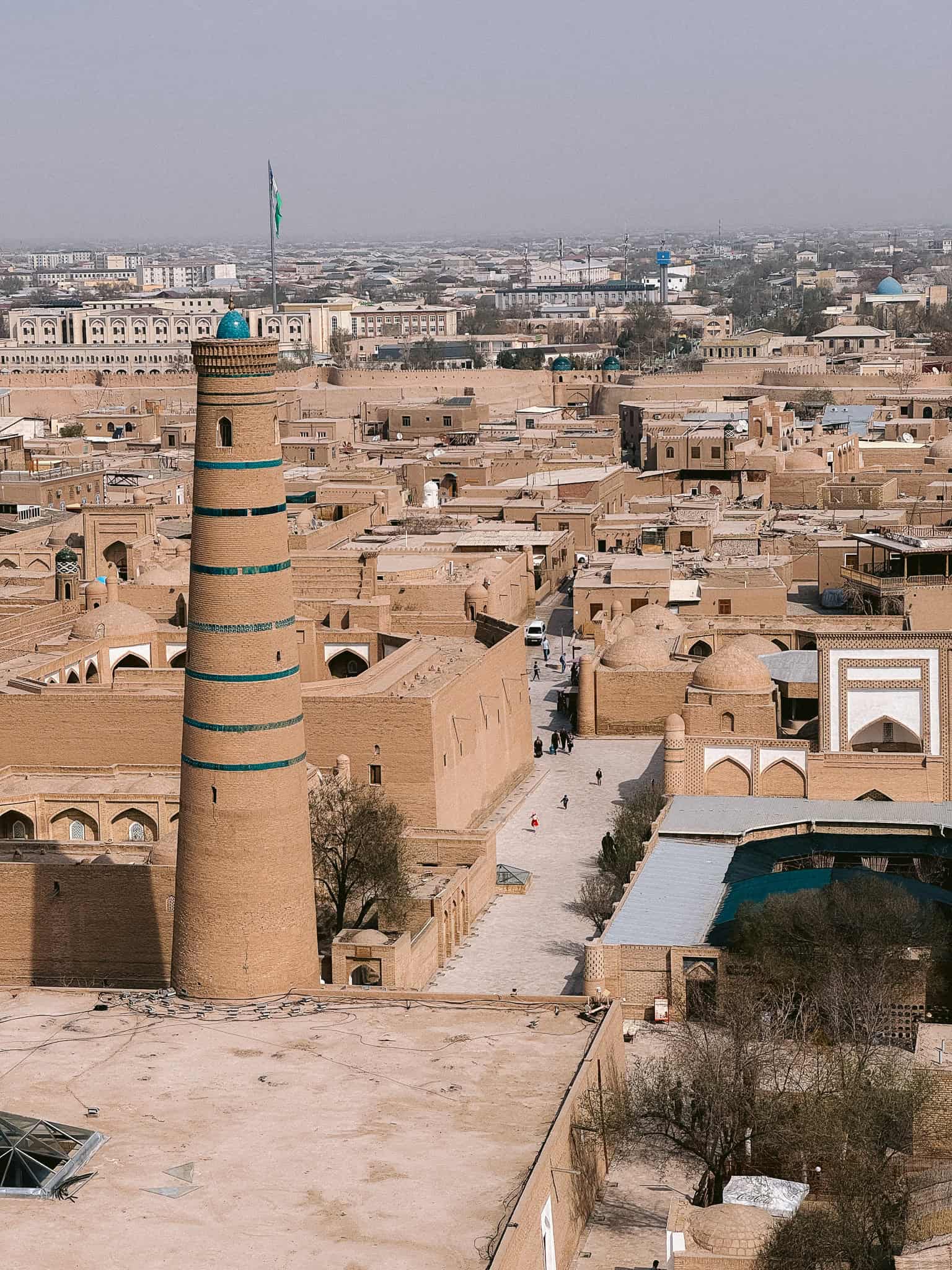
The best thing about Khiva is that it’s made for wandering. If you’re not into checking off a list of attractions, you’re in luck. Khiva’s old town — Itchan Kala, a UNESCO World Heritage Site — is a walled city straight out of the Silk Road era. Compact and walkable, it’s easy to lose track of both time and direction as you meander its labyrinth of mudbrick alleys and little courtyards. The beauty is that you don’t need a plan here — just start walking, and you’ll naturally stumble upon nearly every landmark I mention below. How cool (and efficient) is that?
2. Marvel at the Kalta Minor Minaret’s Unfinished Beauty
If there’s one landmark photo of Khiva, it’s gotta be the Kalta Minor Minaret inside Itchan Kala. It’s eye-catching, distinct, and fat. Yes, in a sea of Islamic minarets that are tall and lean, the Kalta Minor is the short, fat one. And yet, I couldn’t take my eye off of it, and you likely won’t either.
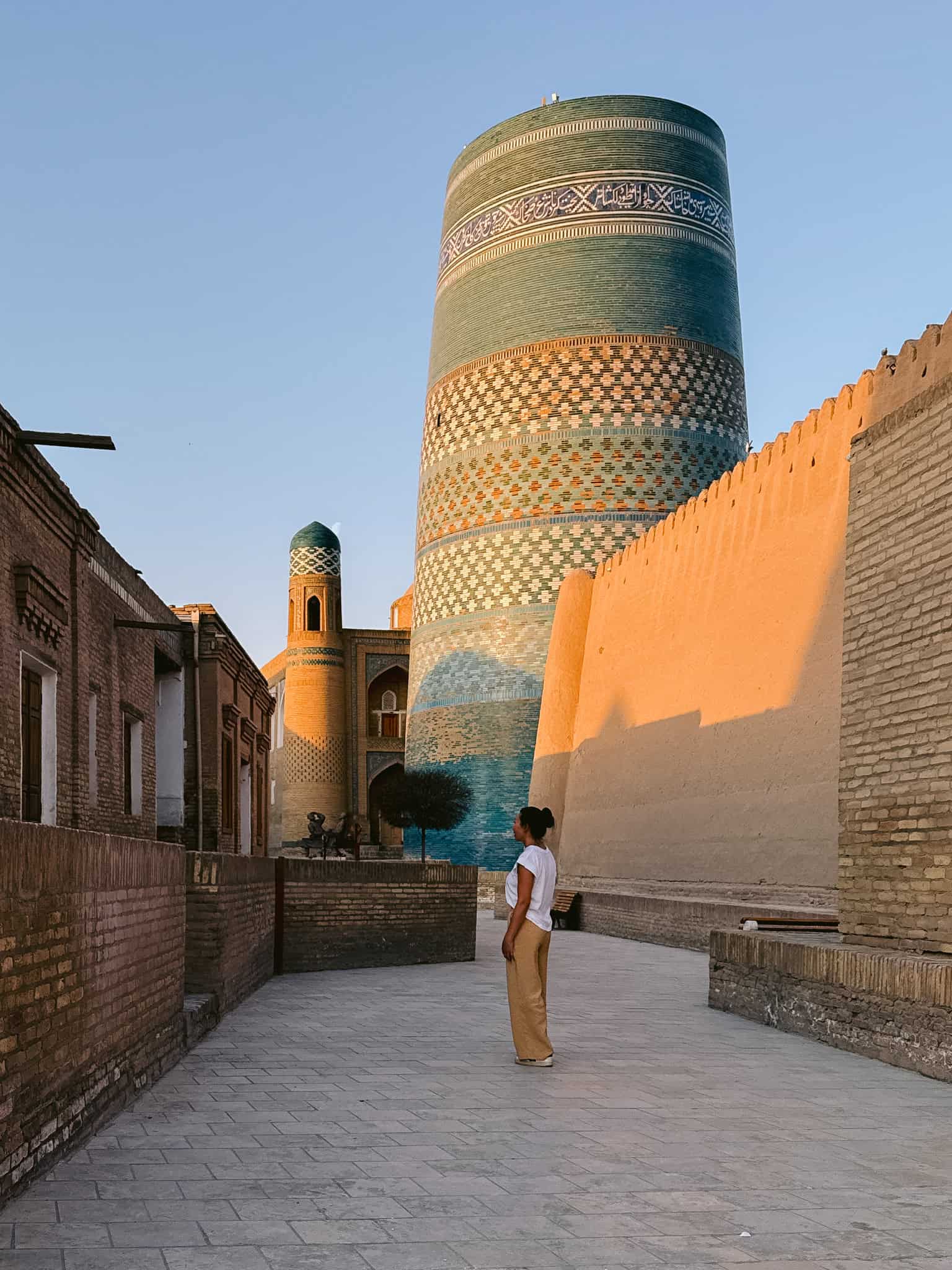
Constructed between 1851–1855, it was originally meant to be one of the tallest minarets in the Islamic world, built under Muhammad Amin Khan as a statement piece for the Silk Road city of Khiva. But the untimely death of the Khan who commissioned it left it forever unfinished. Today, it stands about 29 meters tall, wrapped in shimmering bands of turquoise, blue, and green glazed tiles that catch the desert light at every angle — quite the unfinished work of art.
💡 Tip: The best time to see the Kalta Minor Minaret is at sunrise, when it’s bathed in soft golden light and framed by the mudbrick walls of Khiva’s old walled city. You’ll have it all to yourself before the day trippers and tour groups arrive.
3. Climb the Kuhna Ark Watchtower for Sunset Views
The Kuhna Ark, located inside Itchan Kala, is the old fortress and citadel in Khiva and the former residence of the ruling Khans. It was once a palace, government center, and defensive stronghold all in one — the heart of Khiva’s Silk Road-era power. As a visitor, you can explore the palace grounds and dip in and out of its rooms, which now operate like a museum within this UNESCO World Heritage Site.
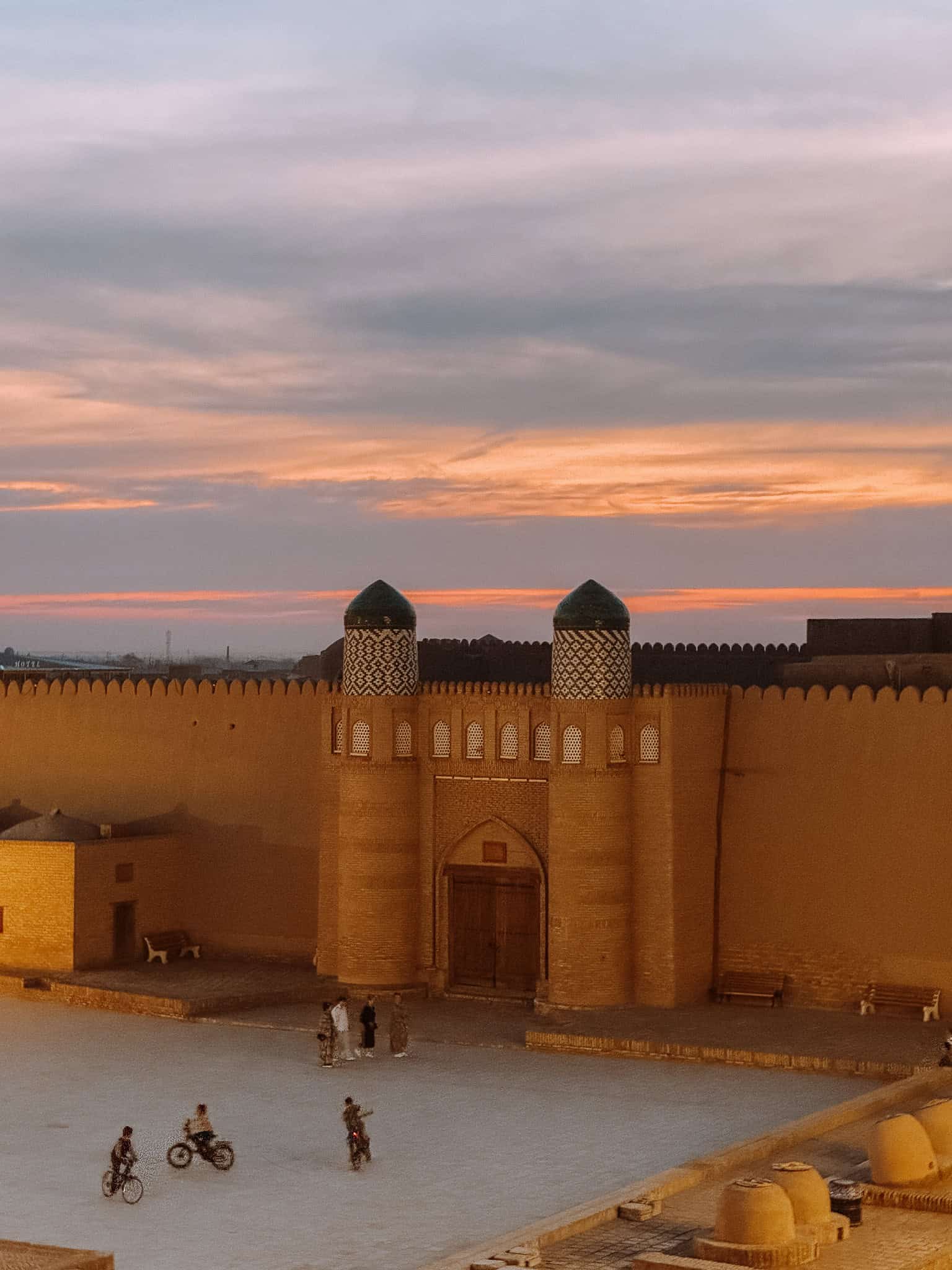
While the grounds and museum are fun to explore, the real stunner is the watchtower you can climb. It’s one of the few viewpoints in Khiva that offer a sweeping panoramic view over the mudbrick old town. From the top, you can see the city walls, the contrast between the modern city outside Itchan Kala and the ancient maze within, plus postcard-worthy views of the Kalta Minor Minaret, Islam Khodja Minaret, and the Mohammed Amin Khan Madrassa.
Go at sunset for the beautiful golden light that descends over Khiva. Plus, most day trippers will have left the old town by then so you’ll have this UNESCO-listed Silk Road city practically to yourself.
4. Step Inside the Juma Mosque’s Forest of Columns
If you’ve traveled off the tourist trail, I’m sure you’ve seen your share of mosques. But, I’m also sure you’ve likely never seen one that looks like Juma Mosque in Khiva’s Itchan Kala, a UNESCO World Heritage Site along the Silk Road.
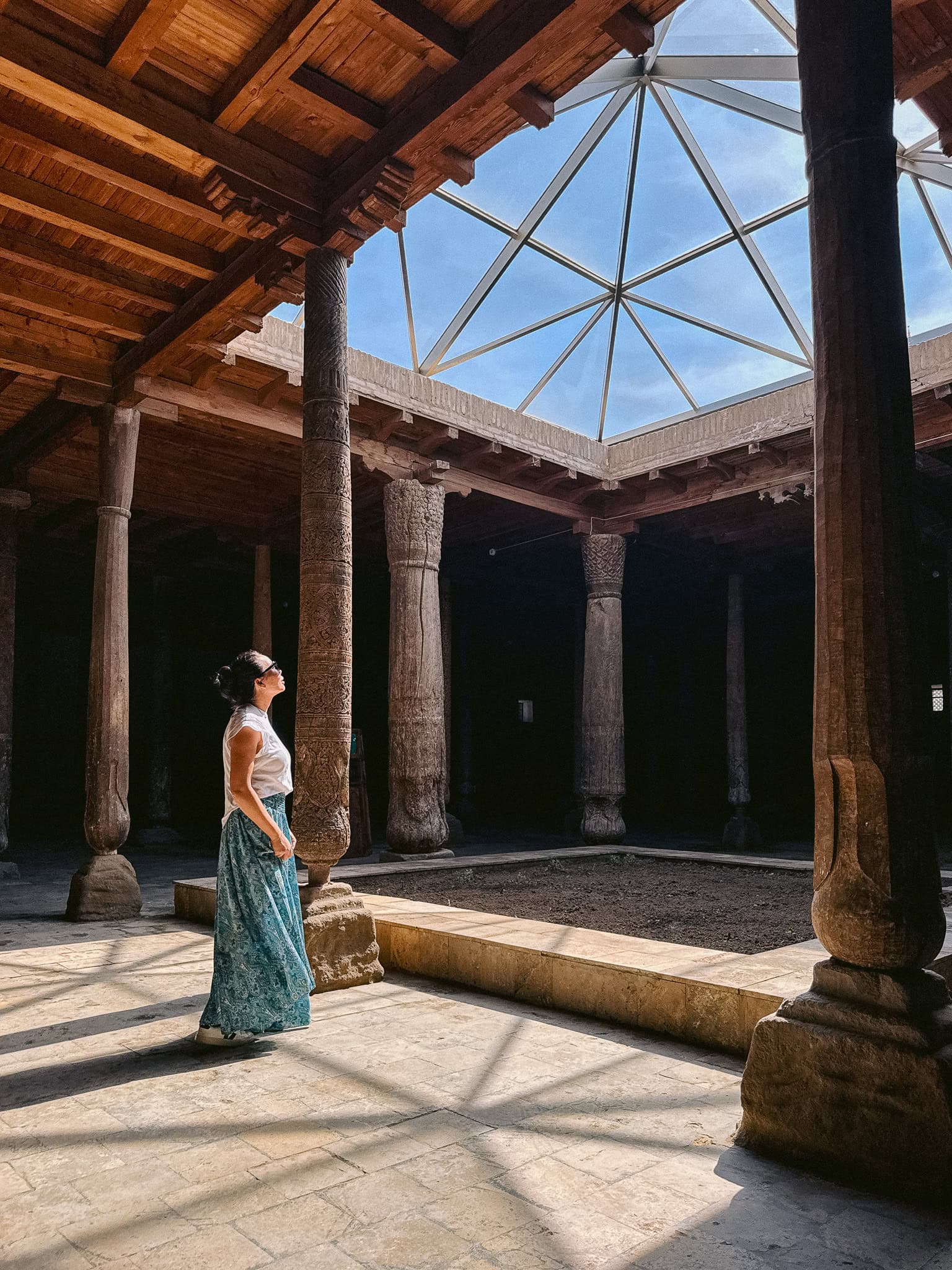
First of all, you might miss this mosque if you’re walking by because it’s not as fancy on the outside as other mosques. Step inside, however, and you’re immediately transported to what feels like an enchanted forest of 213 carved wooden pillars, each one slightly different, stretching across the mudbrick interior of this ancient Friday Mosque. Some of the pillars are over 1,000 years old, dating back to earlier dynasties of the Khorezm region.
If you come at the right time, you might catch the sunlight beaming in through the tiny holes in the ceiling, perfectly aligning the beams with the pillars. It’s magical, serene, humbling, and even a little hypnotic to walk through Juma Mosque, one of the most atmospheric sites in all of Central Asia.
5. Visit the Islam Khodja Minaret for a Bird’s-Eye View
I told you about the short and stubby minaret in Khiva, but let’s talk about the tall lean one now. Islam Khodja Minaret, part of the Islam Khodja Complex inside the city’s mudbrick walls, is the tallest structure in Khiva at 56 meters high and one of the most recognizable silhouettes along the Silk Road skyline.
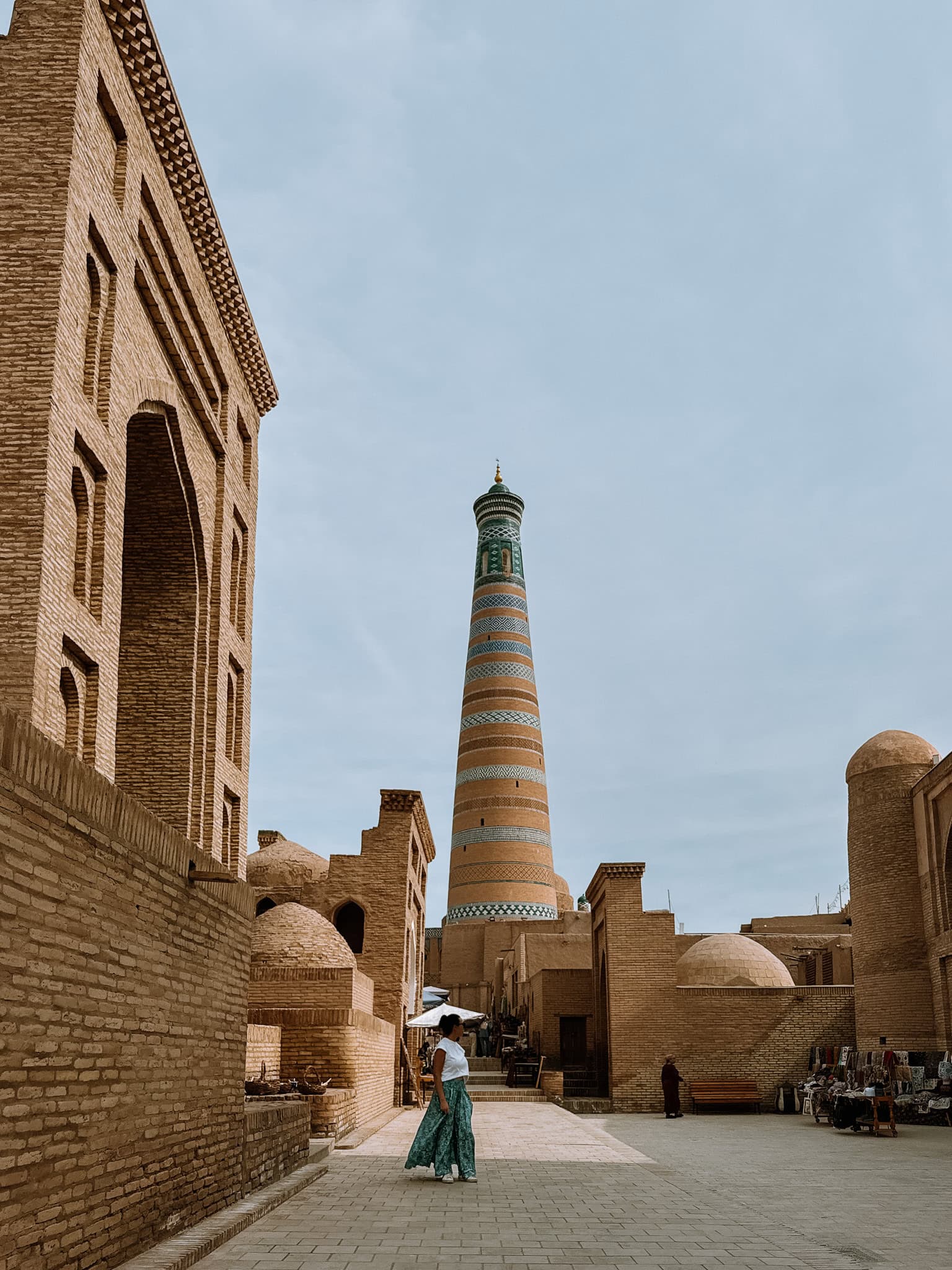
While the minaret looks centuries old, it was actually constructed in 1910 by Islam Khodja, the Khan’s vizier, as part of his push to modernize Khiva, a UNESCO World Heritage walled city. Unfortunately, people saw his attempts to modernize as a threat to tradition and power and he was promptly executed (maybe even beheaded – yikes!).
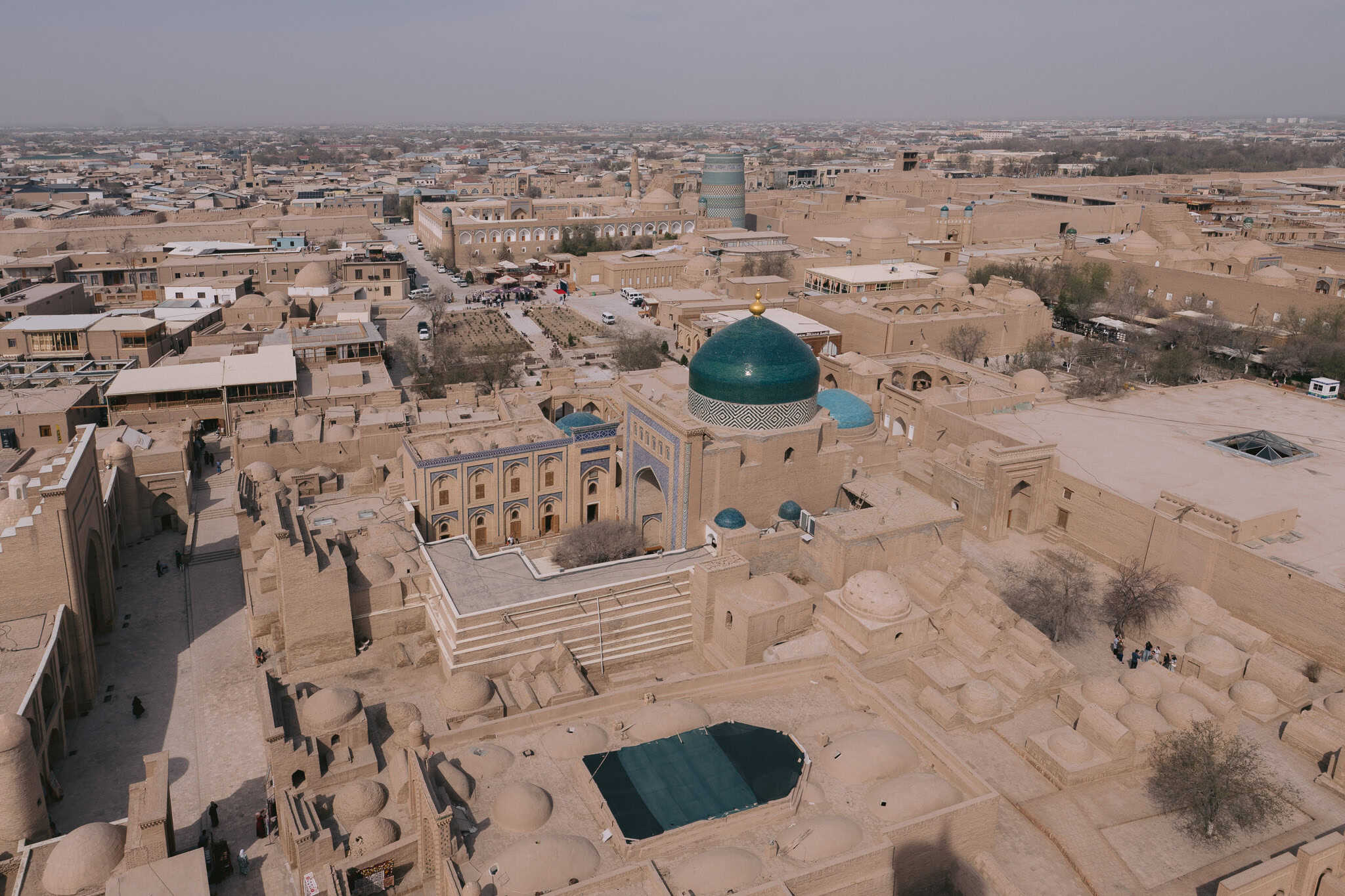
Dark history aside, you can’t miss the Islam Khodja Minaret because it’s visible from everywhere in the old town. If you’re up for it, you can also climb the narrow spiral staircase for sweeping panoramic views over the mudbrick rooftops of Khiva. This is the highest vantage point you’ll get, so I highly recommend it (no pun intended)! Just be careful: the staircase is steep, dark, and windy, so don’t be an idiot like me attempting to ascend the minaret in flowy pants as you could easily slip.
6. Explore the Tash Khauli Palace (Tosh-Hovli)
Built in the 19th century by Allakuli Khan, the Tosh-Hovli Palace (“Stone House”) is the royal residence of Khiva’s Khans.
It was built to compete with the Kuhna Ark, so that the Khans could have something a bit more private and a whole lot grander because… if you’ve been along Uzbekistan’s Silk Road long enough, you’ll realize “simple” and “understated” was the farthest thing from the architecture of the Khivan Khanate!
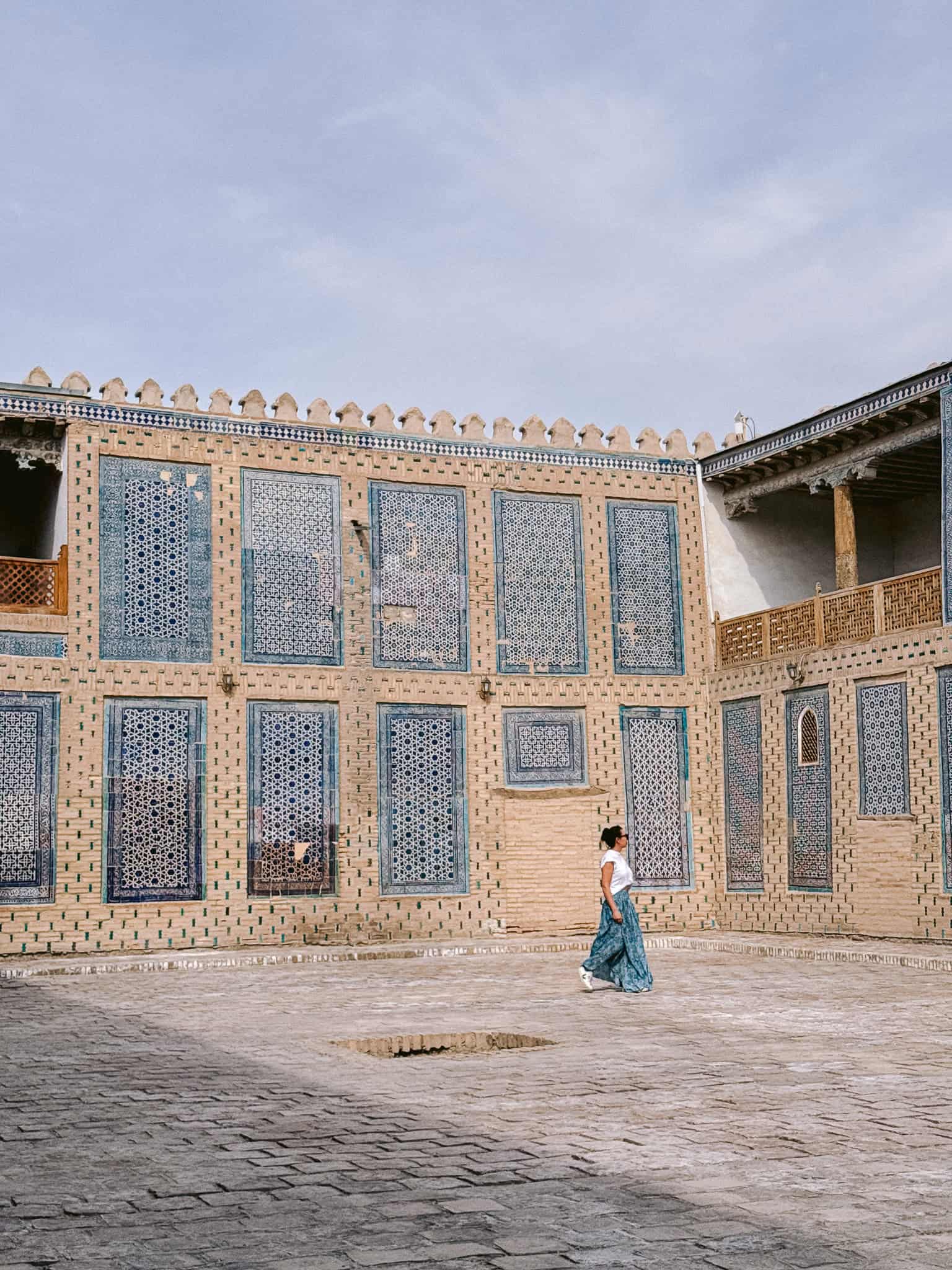
Today, you can visit the palace, see its rooms and courtyards, and admire the intricate detail of the designs plastering its walls. The Khivan tilework, carved wooden ceilings, and ornate stucco patterns are mesmerizing — some of the walls are so fancy, it’s giving more “tapestry” than tiles or paint!
This is also the palace where a whole section was kept for the Khan’s harem of 40 women, tucked away in the harem courtyard behind turquoise walls. What a soap opera this Silk Road palace must have been!
7. Pay Respects at the Pahlavon Mahmud Mausoleum
“Poet” and “wrestler” aren’t often the words you use to describe a person, yet that’s exactly who Pahlavon Mahmud was. He was a Sufi poet, philosopher, and wrestler who became Khiva’s patron saint, and his mausoleum is one of the most revered sites in the historical core of Khiva.
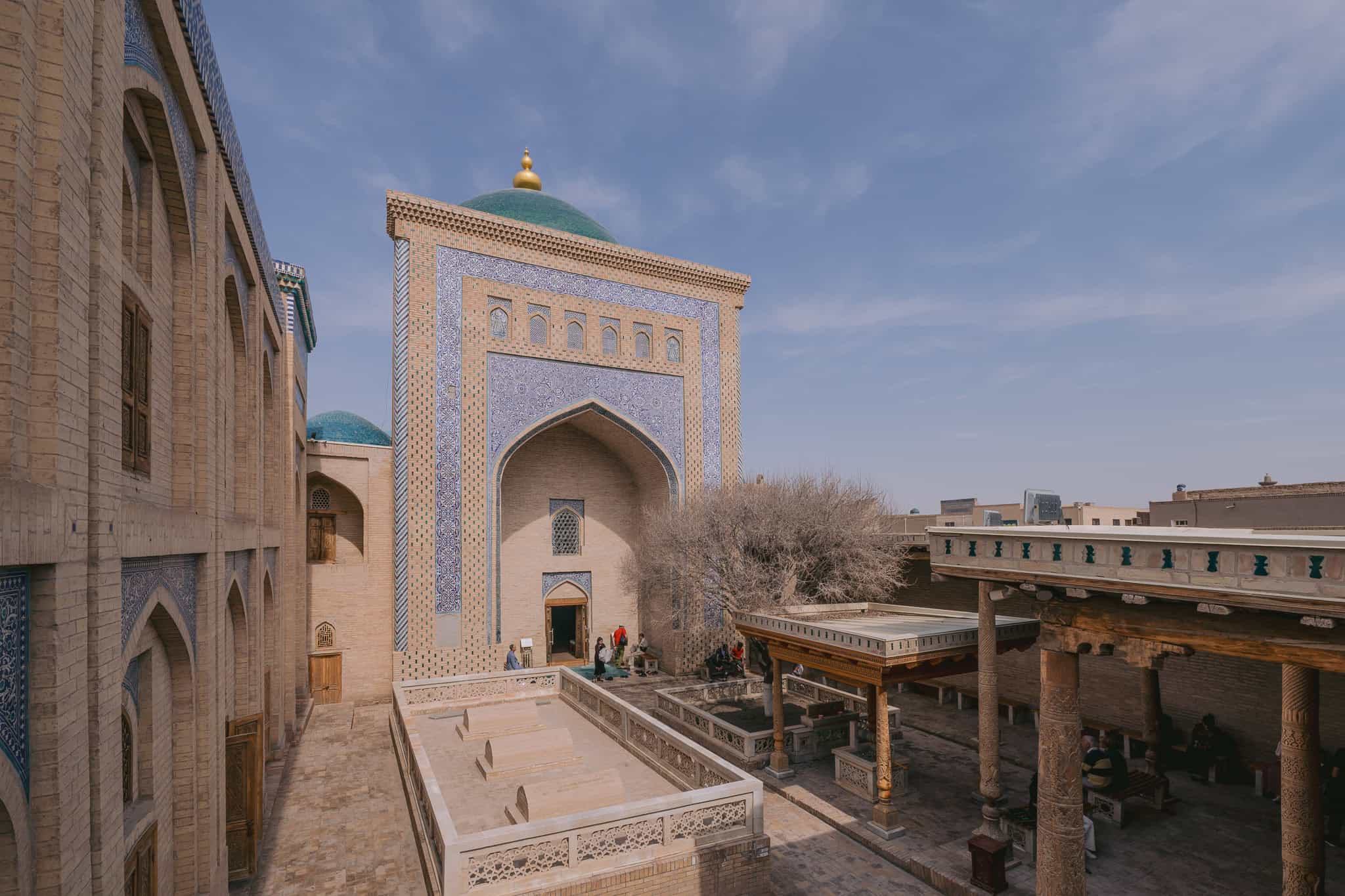
You can visit his mausoleum to admire the grandeur of the space inside — blue and turquoise tilework adorning the walls and a space that feels sacred and still. The Pahlavon Mahmud Mausoleum is also the final resting place for Khiva’s Khans, including Isfandiyar Khan, who chose to be buried beside the city’s saint for spiritual protection.
The day I went, a bride and groom walked in to pay respects — a reminder that this isn’t just a historical monument but a living pilgrimage site. I visited after they left, took off my shoes to enter, and walked into the main hall while a local man was singing what sounded like the call to prayer. It was angelic. That’s the kind of first impression that leaves a mark on a place.
8. Discover Local Crafts and Carpets in the Bazaars
While Khiva is very much like a living museum inside the old city walls, it can also feel very touristed and “Disney-esque,” especially when the day trippers spill into the alleys during the daytime. That’s also when all the bazaar vendors come out, selling everything from random knick-knacks (probably made in China), silk scarves, handwoven carpets, wooden carvings, embroidered skullcaps, and local crafts that reflect Khiva’s long history as a Silk Road trading city.
Still, there’s no harm in browsing, right?
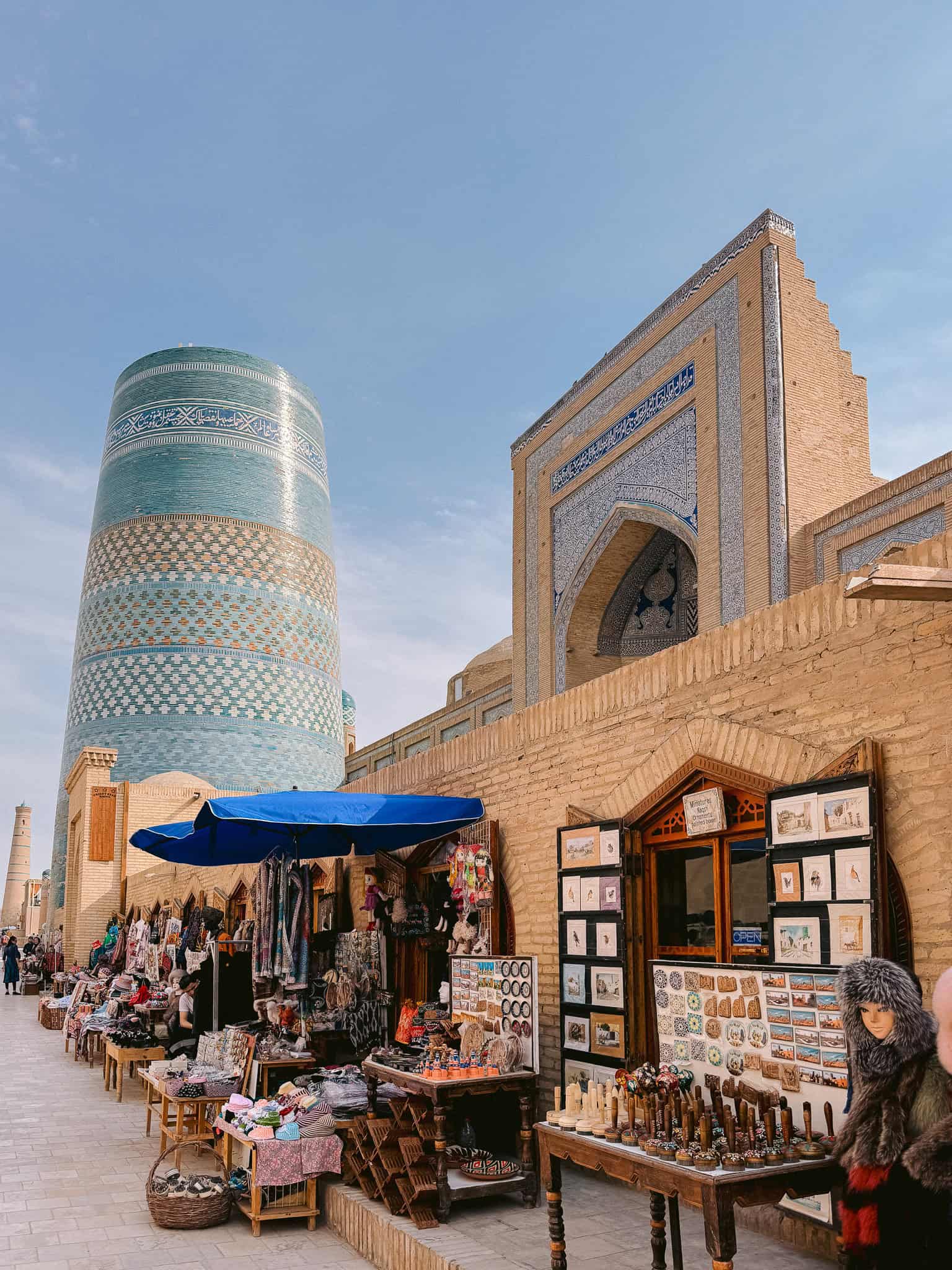
Walk around long enough and peek into little workshops tucked under arched corridors, and you’ll find wood-carving studios, silk-dyeing workshops, and even a caravanserai full of handicrafts and traditional Uzbek garments. If you want to pick up some souvenirs, head to the Allakuli Khan Caravanserai, one of Khiva’s oldest Silk Road marketplaces, and practice your bargaining skills!
9. Eat Uzbek Cuisine in Rooftop Cafes
One of my favorite things to do whenever I travel is hunt down a restaurant with a view, and Khiva did not disappoint. Even better — these restaurants had delicious Uzbek food, so it’s a great opportunity to take in panoramic views of Itchan Kala with a side of plov or lagman.
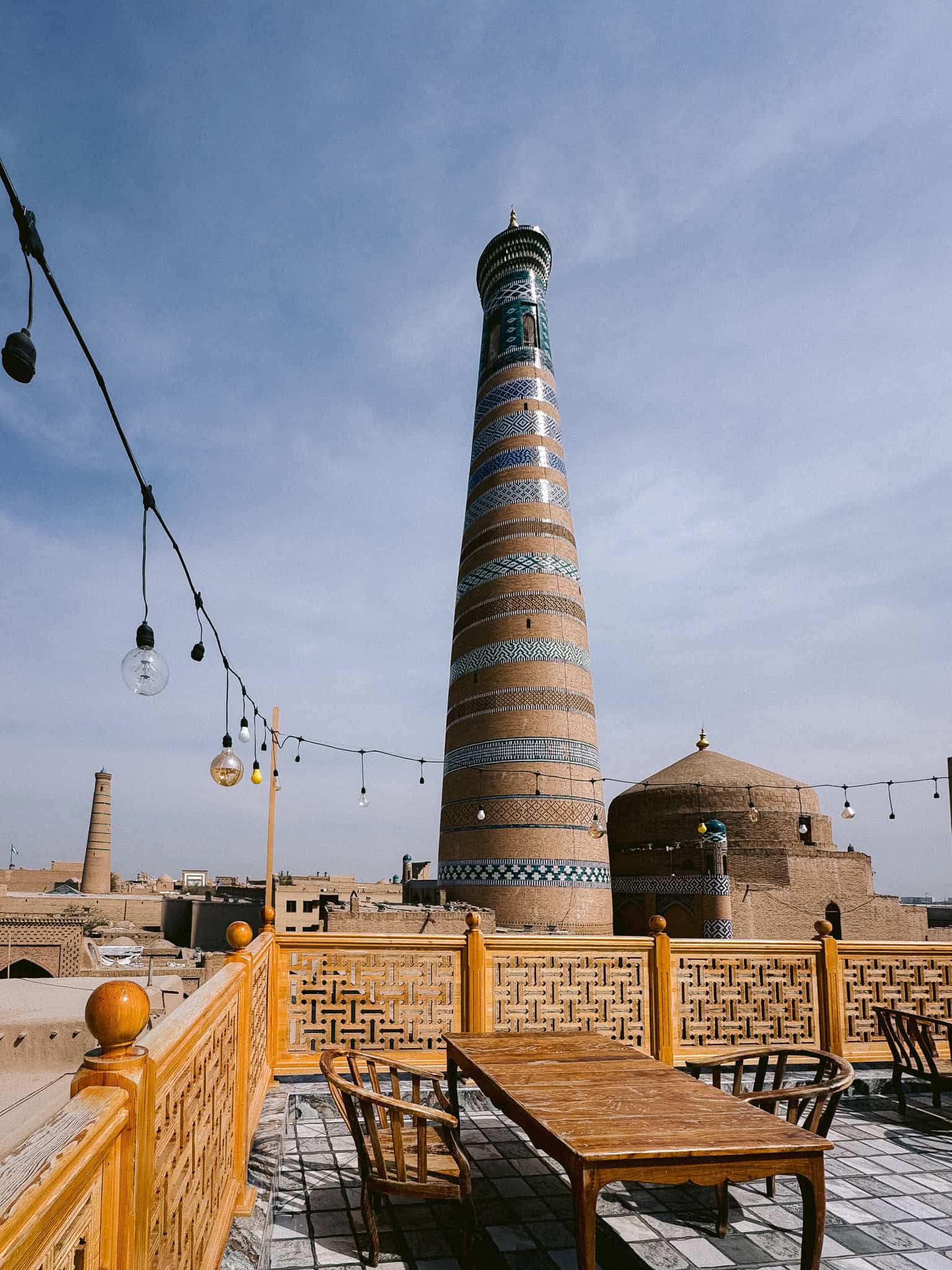
The first is Terrassa Cafe & Restaurant, which is located in a square with perfect views of Kunha Ark, a fortified citadel, on one side and Mohammed Rakhim Khan Madrassah on the other. At sunset, both landmarks light up and the tourists milling around Khiva’s old town are replaced with local families going for a stroll below. I often caught kids playing soccer in the open square. Terrassa serves international cuisine as well as traditional Uzbek cuisine. This is a great place to try shivit oshi, Khiva’s signature green noodles, too.
💡 Tip: If you want to dine on the terrace at Terrassa, you need a reservation. Make the reservation at least a day in advance since this place is popular!
The second restaurant with stunning views is Sultan, right next to the Islam Khodja Minaret. Its rooftop has an incredible view of the tallest minaret in Khiva, plus the madrassas and mausoleums surrounding it. While the rooftop has the best view, Sultan has multiple floors so even if you’re sitting by a window, you’ll still catch the Silk Road skyline outside. Sultan serves classic Uzbek dishes, and the setting is especially atmospheric at night when the minarets of Itchan Kala are softly lit against the desert sky.
💡 Tip: In the day time, it may be too hot to dine on Sultan’s rooftop so plan to come here for dinner if you’re looking for al fresco dining with views!
10. See Khiva at Dawn Before the Crowds Arrive
If you truly want to experience the magic of Khiva at sunrise — tranquil, crowd-free, and filled only with birdsong — morning is the best time to visit. I walked around at dawn and it felt like I had the entire old town to myself. The first rays of sunlight slowly lit up the madrasas, minarets, and mosques, bathing them in a warm, golden glow that made the mudbrick architecture come alive.
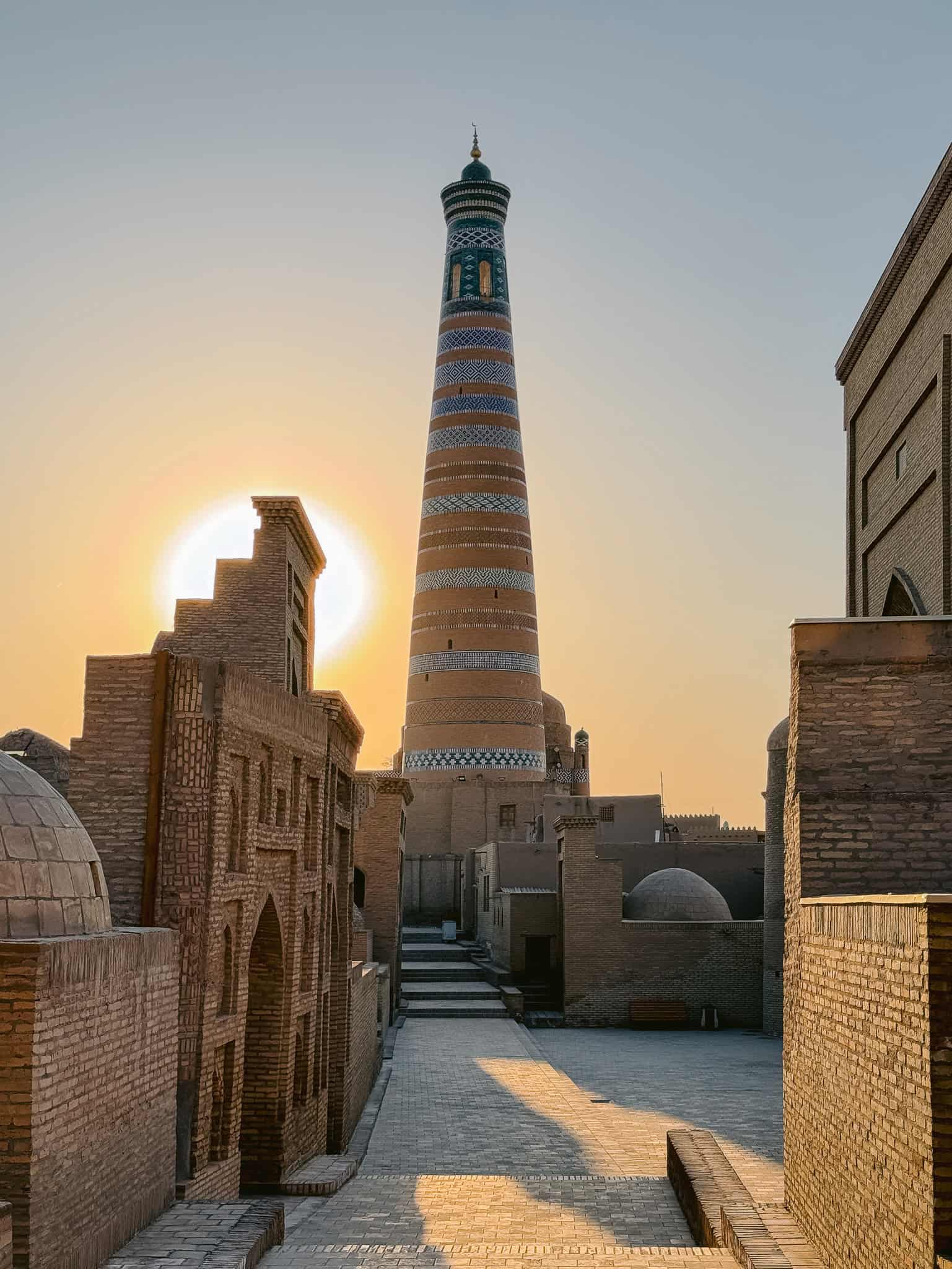
You might also catch locals starting their day: a shopkeeper sweeping his doorstep, the call to prayer drifting through the air. These are the small moments that make Khiva feel alive even in its quietest hour. It’s the perfect time to meander and soak in a side of the city most tourists miss.
💡 Tip: Sunrise is also one of the best times to photograph Khiva. The soft light makes the turquoise domes and sand-colored walls glow which is perfect if you want those postcard shots without the crowds.
11. Walk the Outer Walls of Dishan Kala
We’ve talked a lot about Itchan Kala, but Dishan Kala is the outer part of Khiva, beyond the old town’s mudbrick walls. The two are separated by the fortifications that once protected this Silk Road trading hub and still mark the boundary of the UNESCO World Heritage old town.
I recommend taking a stroll outside the city walls for another perspective of Khiva as well as walking along the ramparts themselves. The entrance to the wall is right after the North Gate (make sure your ticket for Itchan Kala includes the wall’s entrance) and then make your way to a small gate with a short but narrow staircase that leads to the top.
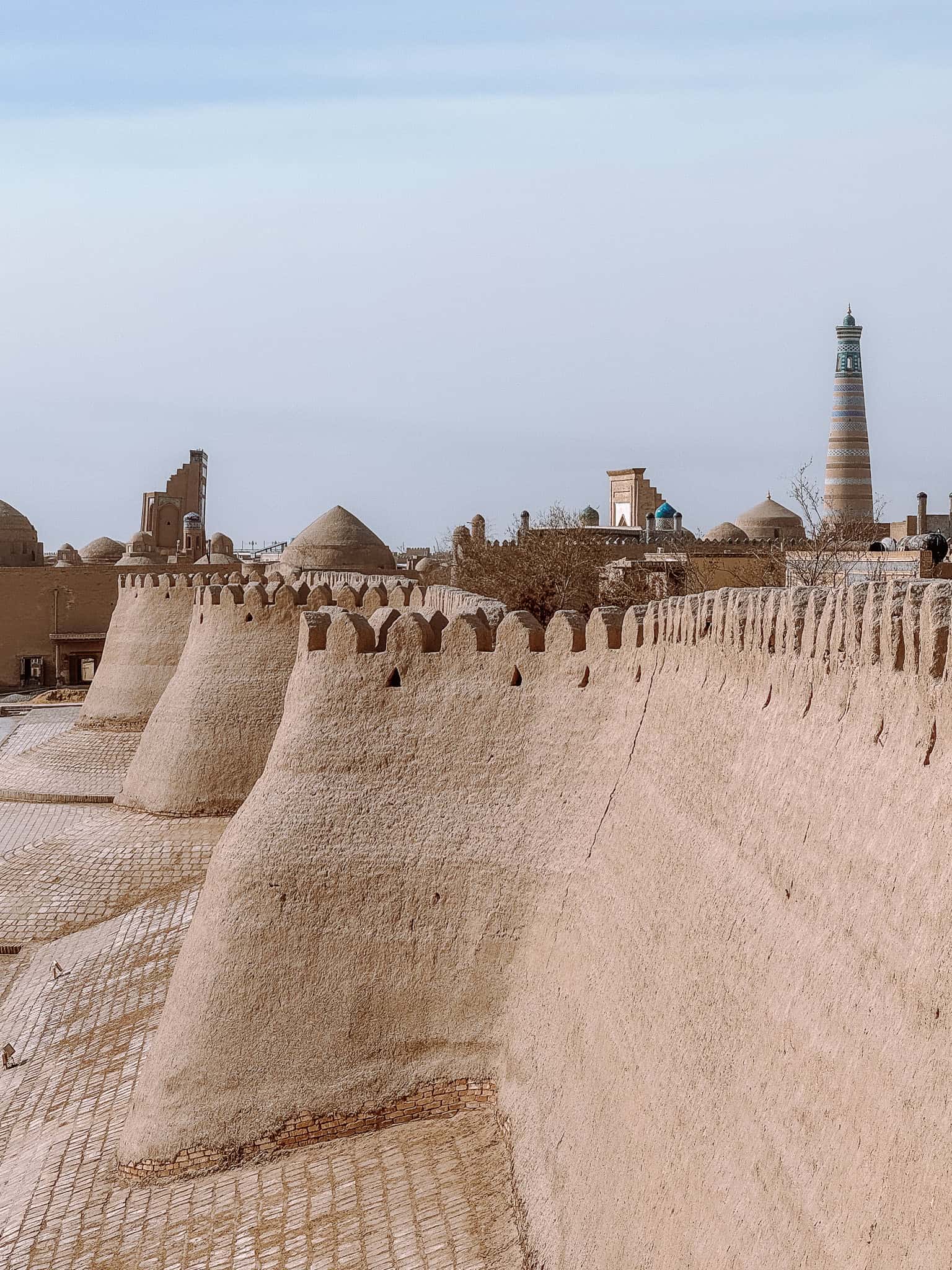
While the walls technically surround the entire town, you can’t actually walk all of it — only a small restored section. Plan about 30–45 minutes to explore and take photos. From up here, you’ll get a panoramic view of Itchan Kala, see the minarets and domes peeking over the skyline, and get a closer look at the curved mudbrick design that gives Khiva its distinct look.
12. Visit the Khorezm Silk Museum
In full transparency, I didn’t visit the Khorezm Silk Museum (I went to another, smaller one), but I wish I had since it’s TripAdvisor’s #1 thing to do in Khiva! 😂
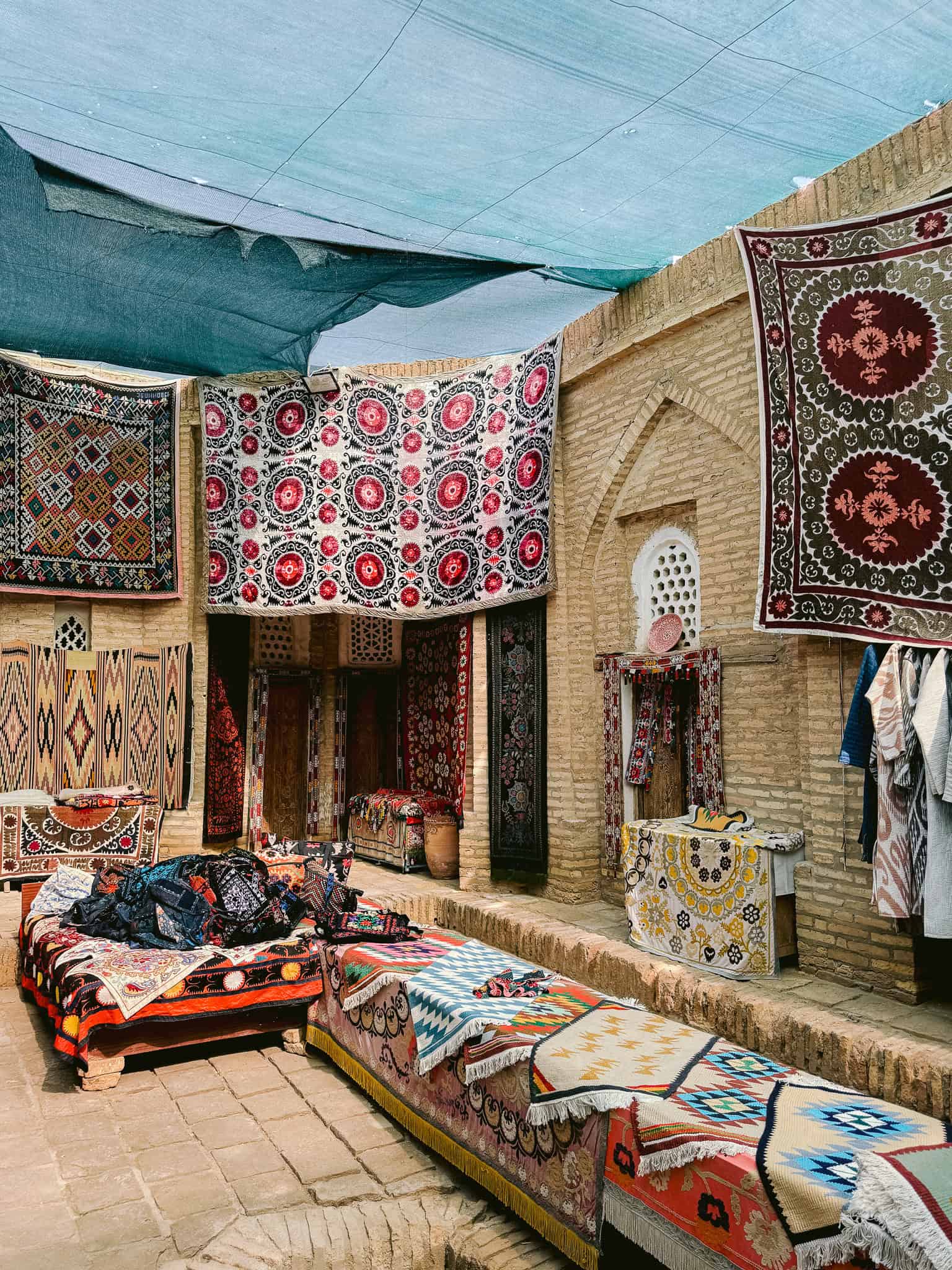
The museum is located just outside Itchan Kala and it’s dedicated to preserving the silk-making traditions of the Khorezm region, which was once a major Silk Road trading hub.
A visit to the museum is a great way to learn about Khiva’s silk history — you’ll see how artisans dye the silk with natural pigments and weave it into intricate carpets and textiles using traditional looms. As a bonus, visitors can dye their own silk scarf, which sounds like the kind of hands-on experience I’d love. Definitely something I’m saving for next time.
13. Wander through Mohammed Amin Khan Madrassa
If you’re looking at the Kalta Minor Minaret, you might as well step inside the Mohammed Amin Khan Madrassa, which is right next to it inside Itchan Kala. Like all madrasas, this one is grand in scale with symmetrical archways, glazed blue tiles, and Islamic geometric patterns begging to be photographed.
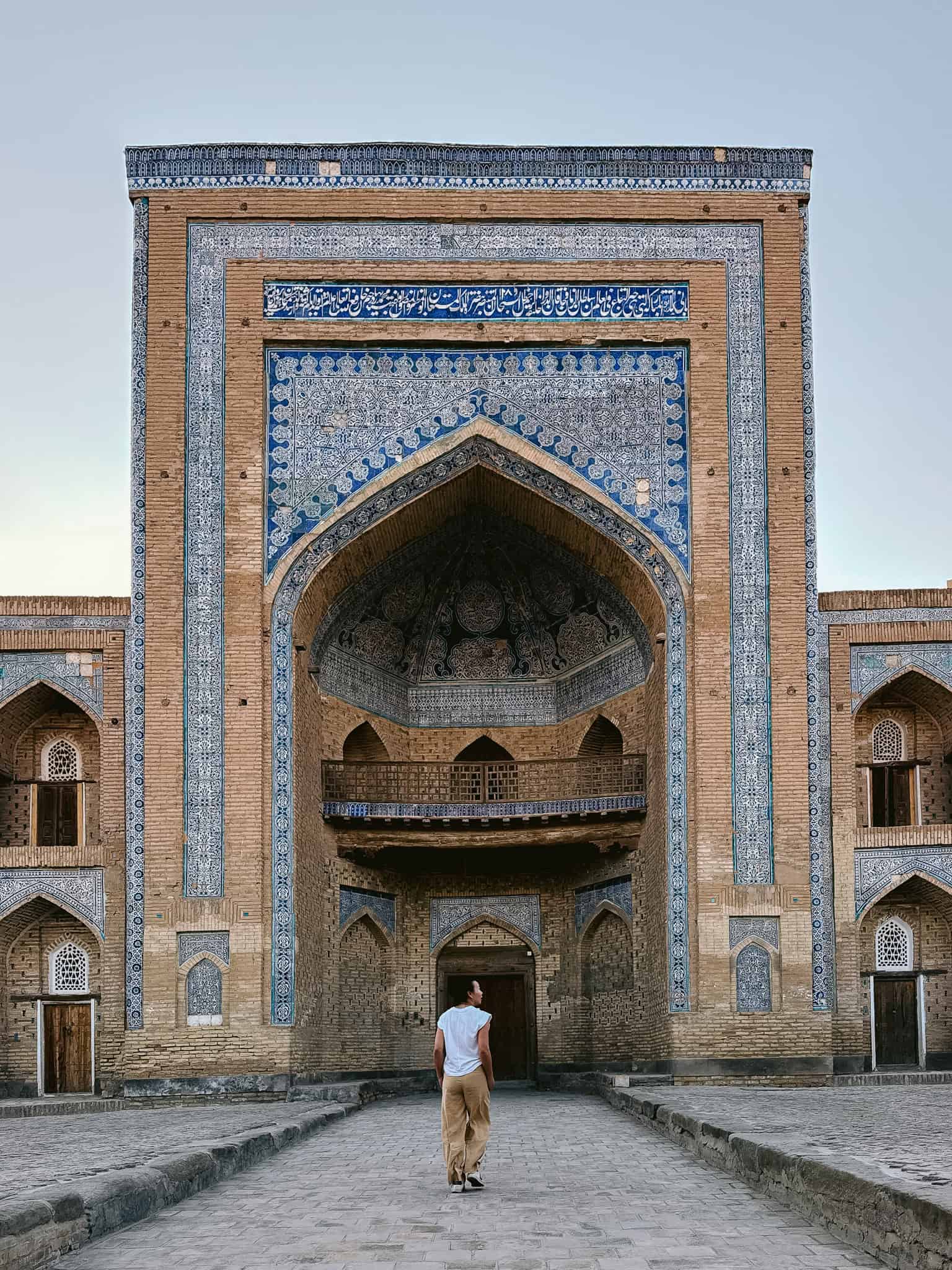
Built in the mid-19th century by Mohammed Amin Khan, this madrassa once housed hundreds of students and served as one of the largest Islamic schools in Central Asia. It was built to demonstrate both his power and Khiva’s influence along the Silk Road.
Today, this madrassa has been turned into a hotel — the Orient Star Khiva Hotel. If you’re looking for a unique, budget-friendly stay that’s centrally located within Itchan Kala, this is a great option. The rooms are set in the old student cells, so you’re literally sleeping in a piece of Khiva’s history.
If you’re not staying at the hotel, you can still walk into the courtyard to admire the architecture and take photos.
14. Visit Nurullaboy Palace
I had Nurullaboy Palace on my list but I was too enchanted by Khiva’s old town that I didn’t bother heading there since it’s located in Dishan Kala, just outside the walls.
That said, if you want to see something a little different from all the classic Khivan architecture, head to Nurullaboy Palace to get a taste of what European influence looked like here during the Khivan Khanate period.
Today, the palace is a museum that shows what life was like for Khiva’s rulers. Visitors can see its ornate rooms, frescoes, chandeliers, and furnishings, which contrast the mudbrick and turquoise tones inside the old town.
15. Take a Day Trip to the Ancient Desert Fortresses of Khorezm
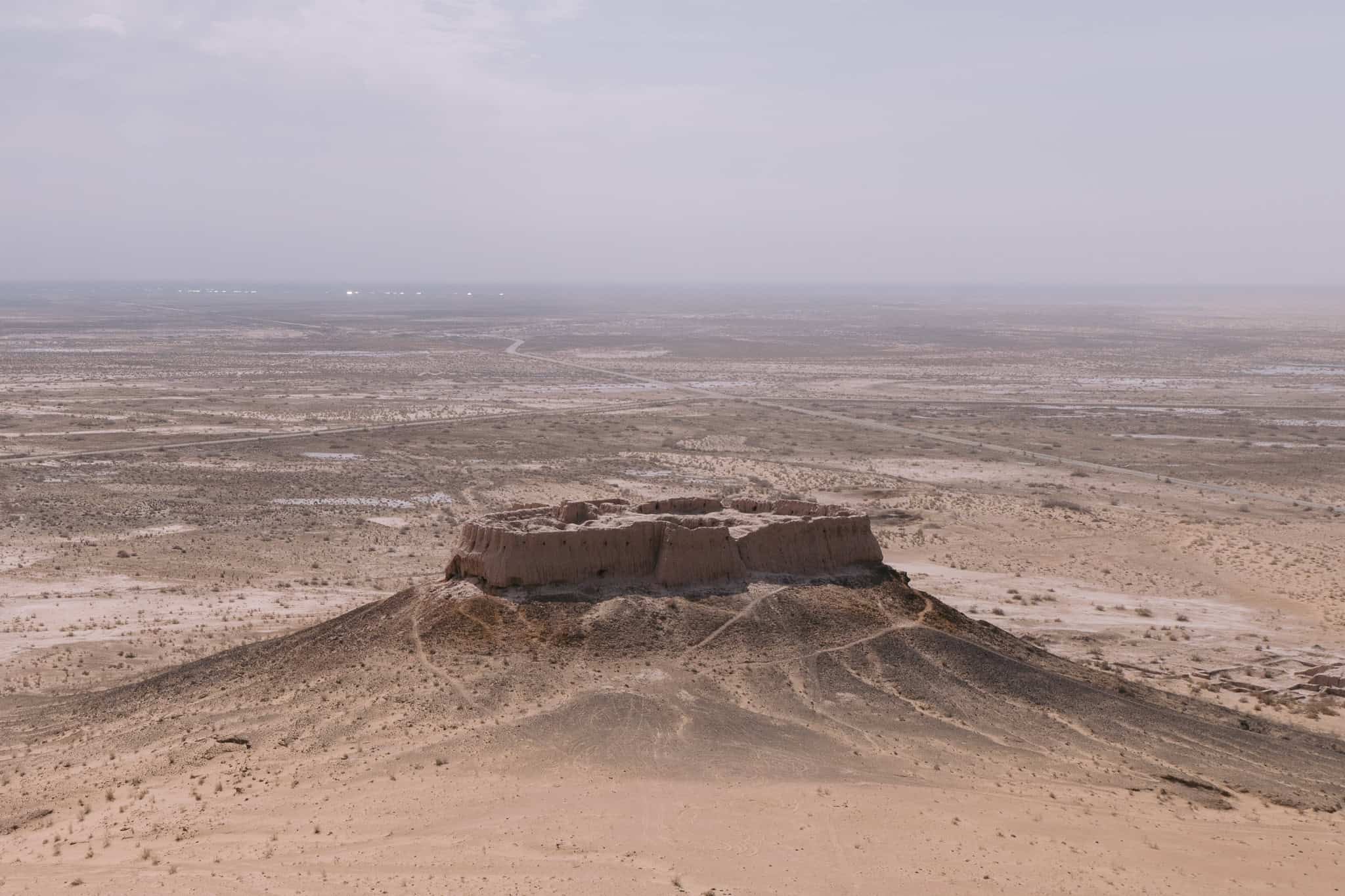
Did you know there’s an autonomous region in northwestern Uzbekistan called Karakalpakstan? And that within Karakalpakstan’s Kyzylkum Desert, there are around 50 ancient fortresses, known as the Elliq Qala (meaning “Fifty Fortresses”), built between the 4th and 7th centuries?
While most have been left to crumble under the desert sun and wind, these fortresses are a striking reminder of what the Khorezm Kingdom once was — a powerful center of trade and culture along the ancient Silk Road. And not only can you visit them, you’ll likely be the only tourist there.
If exploring these mudbrick fortresses intrigues you, plan a day trip from Khiva to visit them. The top sites to see are Ayaz Qala (they say there are three separate forts here, but I only saw two… still, you’ll want to come for the dramatic photo op of the fortress rising from the desert) and Toprak Qala (an old Khorezm capital with visible palace ruins and walls — the view of its square rooms from above reminded me of Squid Game).
💡 Tip: There are daily tours that depart from Khiva for the fortresses. Seeing three is enough but the truly adventurous can do the full Elliq Qala circuit circuit and see up to 10+!
How to Plan Your Time in Khiva (with sample itineraries)
Even though you can see Khiva on a day trip, I don’t recommend it. That’s when the serene version of Khiva disappears and gets replaced by the ruckus of tour buses parked outside the city walls, vendors spilling into the streets, and guides herding groups around the sites within the old town. It gets crowded fast. And if that’s the only version of Khiva you see, it’ll feel like a glorified Disney Park — just with mudbrick walls that look a little too perfect to feel real.
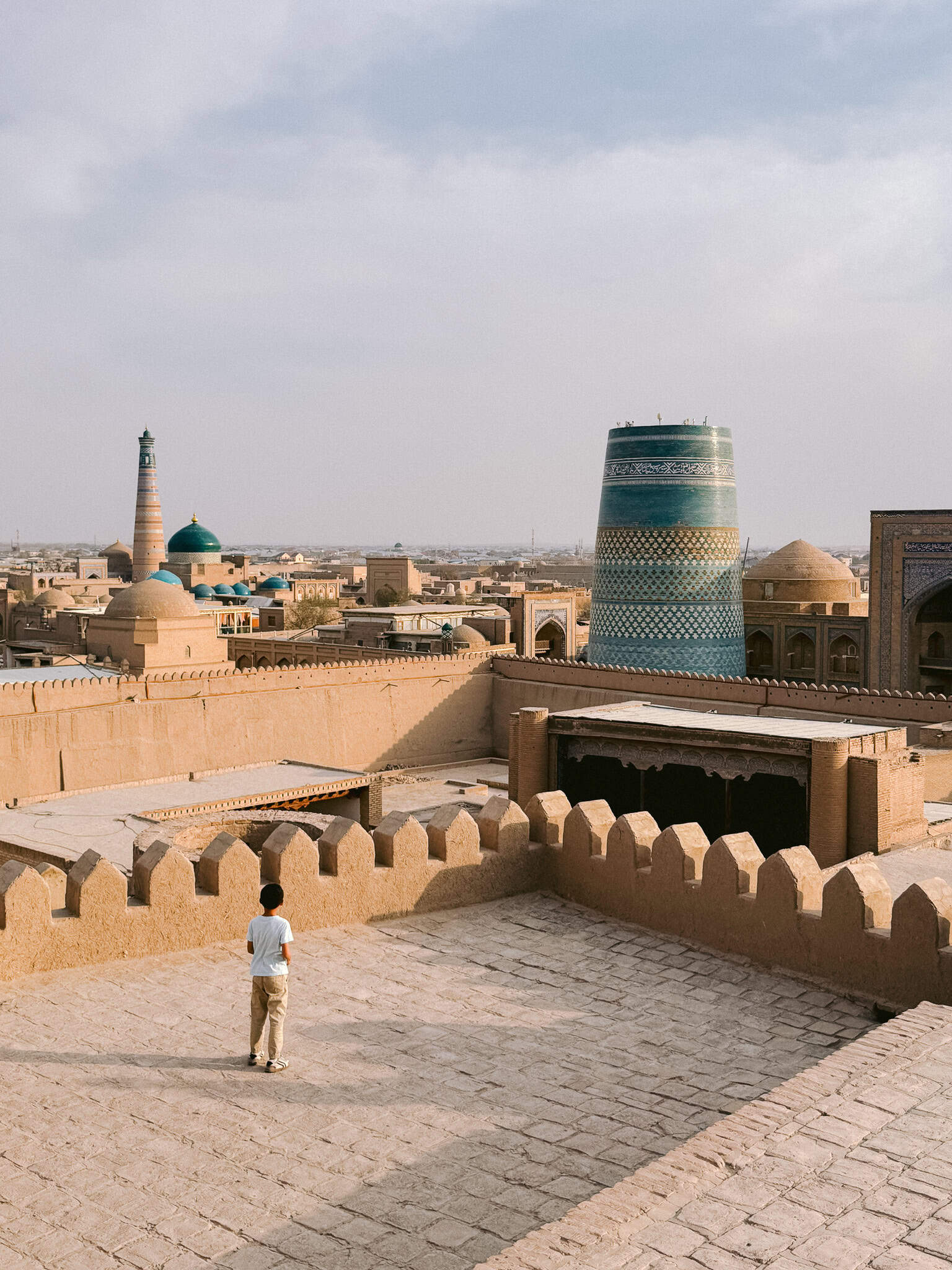
Instead, space out your time in Khiva so you can really take it all in. Here’s how I’d plan it:
If you have 3 days in Khiva:
🕰 Day 1:
Arrive in Khiva in the mid or late afternoon. Check into a hotel within the old town walls (staying inside makes all the difference). Then head to a local cafe for drinks and just enjoy the atmosphere. By this time, the bustle will be cooling down, the evening lights will start to glow, kids will be playing in the courtyards, local families will come out for evening strolls, and the air will smell like street food. End the night with dinner at one of Khiva’s rooftop restaurants overlooking Itchan Kala.
🌅 Day 2:
At sunrise, head out to wander the nooks and crannies of the old town. This is the perfect time to take photos and savor the tranquil side of Khiva. You can probably walk the whole city in under an hour. After you get your fill of Khiva’s photogenic streets, head back to your guesthouse or hotel for breakfast.
Then, go explore. While you can totally meander and get lost (half the fun of visiting!), here’s a suggested walking route that hits all the highlights:
- Walk the old town walls
- Visit Tash Khauli Palace
- Dip into the Allakuli Khan Caravanserai
- Climb the Islam Khodja Madrasa
- Visit Juma Mosque
- Stroll around Kalta Minor Minaret
- Stop in Mohammed Amin Khan Madrassah
- Visit the Khorezm Silk Museum
- Visit Kuhna Ark and climb the watch tower for views (preferably at sunset)
You can get all these done in a day including stopping for lunch, browsing shops, and enjoying tea at a chaikhana (traditional teahouse).
Afterwards, enjoy strolling Khiva’s lively night time atmosphere, especially if you didn’t get to do it the night before.
💬 Prefer a guided experience instead?
🇺🇿 Join the “Essentials of Khiva: Ancient City Guided Walking Tour”
If you’d rather have a local expert bring the stories of Itchan Kala to life instead of doing the self-guided route, this half-day tour is a great option! It’s got wonderful reviews, is affordable, and covers Khiva’s main landmarks — all while sharing the legends and history that shaped this Silk Road city.
💡 Why I like it:
– Great value for money (high reviews and a low price tag)
– Easy, efficient, and the perfect way to hear a local’s perspective
– Gives you time later to relax, photograph, or enjoy a rooftop dinner
👉 Check availability here
🏜 Day 3:
Today’s the day to venture beyond the walls. Visit Nurullaboy Palace in Dishan Kala or take a day trip to the desert fortresses of Khorezm. Either way, you’ll get a new perspective on Khiva’s place in Silk Road history — from royal palaces to ancient trade routes.
This itinerary gives you ample time to linger in Khiva, go at a restful pace, and see it at sunrise and sunset. I truly believe that it’s those “in between hours” when other tourists have left that Khiva feels like a fairytale city frozen in time.
🇺🇿 Ready to see what’s beyond Khiva?
Take a day trip into the Karakalpakstan desert to explore the ancient fortresses of Khorezm — the same ones that once guarded Silk Road trade routes. You’ll wander crumbling mudbrick walls, climb desert citadels, and imagine what life was like here centuries ago.
👉 Check out the available day trips from Khiva here.
If you only have 1 day in Khiva:
If you only have one full day, just do Day 2 from my 3 day itinerary above. You’ll hit all the major sites inside the Itchan Kala, have time to wander the alleys, and catch sunset from the Kuhna Ark watch tower.
When to Visit Khiva
Spring (April–May) and autumn (September–October) are ideal. The weather is pleasant, not scorching or freezing. But those months also bring more crowds as tour groups and Silk Road itineraries tend to peak then. If you want fewer tourists, try just before or after. I went in mid-March and had decent weather with only light crowds.
If you can only go in winter or summer, I’d pick winter over summer. At least in winter, you can layer up to stay warm. In summer, temperatures can be well over 100°F (38°C) and there’s almost no shade — plus, Uzbekistan is a conservative country, so it’s not really a place where you’ll want to strip down to shorts and a tank top to stay cool.
If you want more details on what to wear in Uzbekistan, I have a whole section on that in this post.
Where to Stay in Khiva
I recommend staying within the old town so you can easily see it at dawn and sunset. When I’m looking for hotels, I like ones that are walking distance to main sites but in a quiet area, have air conditioning and heaters, and stellar reviews. Hotels with a reputation for providing consistently good service towards guests also ranks high for me!
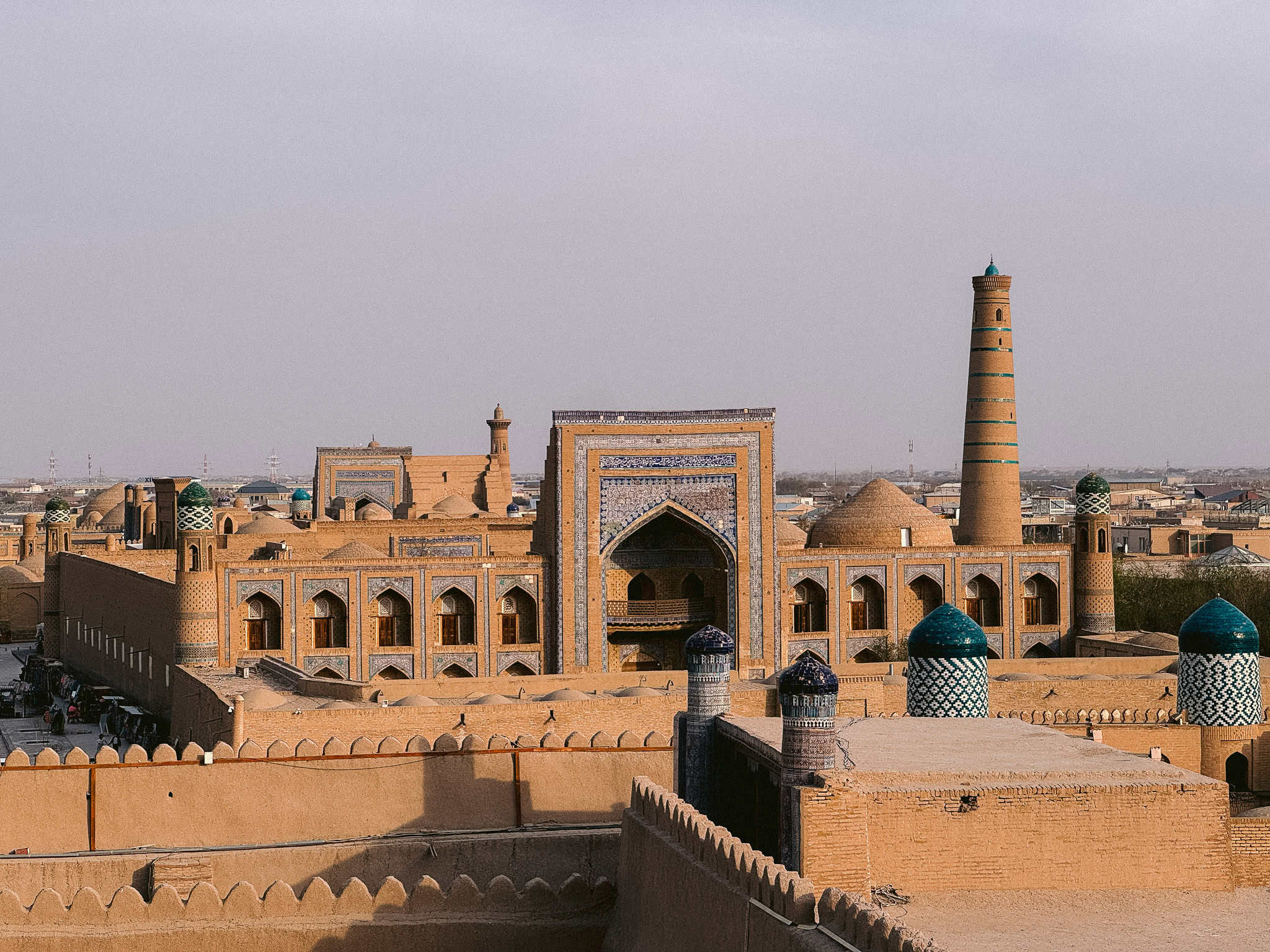
As a result, below are the hotels I recommend for Khiva. Use the dollar signs as an indicator of the relative price of one option to another.
📍Nazira Boutique Hotel ($)
This is the hotel I stayed at. It’s one of the highest-rated options within the city walls. While it’s called a boutique hotel, it feels more like a guesthouse with simple, clean rooms. The owner speaks limited English (his son speaks some), and there’s a terrace for views which is perfect for photos. Prices are lower than other hotels with similar views, which makes it great value.
Check out prices for Nazira Boutique here.
📍Islam Kodja Guesthouse ($)
Excellent reviews, quiet location, right inside the old town walls, and is often recommended by many travelers.
Check out prices for Islam Kodja Guesthouse here.
📍Orient Star ($$$)
Stay inside a converted 19th-century madrassa right next to the Kalta Minor Minaret. I walked by their rooms — they looked clean and comfortable. It’s centrally located within Itchan Kala, and the history of the building makes it one of Khiva’s most unique stays.
Check out prices for Orient Star here.
📍Arkanchi Hotel ($$$)
I almost stayed here because it has great reviews and a terrace view. The rooms look more modern than at Nazira.
Check out prices for Arkanchi Hotel here.
📍Polvonnazir Guest House ($$$)
Another highly rated guesthouse with terrace views, clean rooms, and a fantastic location inside the walled city.
Check out prices for Polvonnazir Guest House here.
How to Get to Khiva
There are three main ways to get to Khiva: plane, train, or automobile.
If you’re flying, look for tickets to Urgench Airport (UGC). While there are a few direct international flights from major European cities, your best bet is to fly into Tashkent first and then take a domestic flight to Urgench. You can search for flights here. Urgench is about 30 min from Khiva by train or taxi. The airport is about 30 minutes from Khiva by train or taxi.
If you’re already in Uzbekistan, train travel is one of the most popular (and economical) ways to get to Khiva. Just be prepared for long travel times. From Tashkent or Samarkand, it’s typically an overnight train, while from Bukhara, expect around 8 hours. You can search for trains directly to Khiva or to Urgench — the latter sometimes has more frequent departures. This is the official website to book trains in Uzbekistan.
The last option is a private transfer. If you have some cash to spare, you can hire a driver to pick you up from any major city in Uzbekistan and take you straight to Khiva. I did this from Samarkand to Khiva, and while it took 10 hours, it was comfortable, left when I wanted, and honestly, it was my only option — the train wasn’t running that day, and a domestic flight would’ve taken seven hours with a layover in Tashkent.
🇺🇿 Need a stress-free arrival to Khiva?
Book a private transfer from Urgench Airport or Urgench Train Station directly to your hotel in Khiva. The driver meets you with a name sign, waits up to 2 hours after your landing, and takes you to your hotel.
👉 Check availability and book here.
⭐ Planning Uzbekistan Just Got Easier
If Khiva has you dreaming about a full Silk Road route but you’re not sure how to actually piece it all together — trains, transfers, day trips, the best routes, and where to start — I’ve got you.
I wrote The Easy Guide to Uzbekistan: Plan it. Book it. Go. so you can skip the guesswork and plan your own trip with confidence. It includes all the logistics I wish I’d known before my trip, plus money-saving tips, transport hacks, and my full 10-day itinerary.
👉 Grab it here — and if you book any tours with Uzbekistan tour guide mentioned in the travel guide, he will give you 20% off!
How to Get Around Khiva
Khiva’s old town is completely walkable, so there’s no need for transport within the walled city of Itchan Kala. You can walk end to end in about 15 minutes, and most of the main sights are just a few minutes apart.
If you’re venturing into Dishan Kala (the part of Khiva outside the walls), use Yandex Go — Uzbekistan’s version of Uber — to get around easily and affordably.
Frequently Asked Questions About Khiva
Yes! It’s one of the most unique Silk Road cities in Uzbekistan and a completely different experience from Bukhara, Samarkand, or Tashkent. Khiva is famous for its well-preserved mudbrick architecture and compact old town — walking through Itchan Kala feels like stepping into a living museum.
While it’s possible to see the major sights in Khiva in half a day, spending 1–2 full days lets you wander at a slower pace, climb the viewpoints, and appreciate the mausoleums and mosques that make this Silk Road city so special. You’ll also get to experience Khiva after the day trippers leave — that’s when it feels the most magical. If you have extra time, add a day trip to the nearby desert fortresses of Khorezm.
You can reach Khiva by plane, train, or private car. The easiest route is to fly or take the train to Urgench, which is about 30 minutes from Khiva by taxi. From Bukhara, it’s an 8-hour train or drive across the Kyzylkum Desert. It’s long but scenic! I’ve done this route by private transfer, and while it’s a full-day journey, it’s comfortable and flexible.
Yes. Khiva is safe to visit, along with the rest of Uzbekistan. The old town of Itchan Kala is small, calm, and walkable, and locals are warm and welcoming without hassling tourists. That said, it’s always smart to take the same precautions you would in any major city: keep an eye on your belongings, especially in busy areas, and stay aware of your surroundings.
Khiva is known for its turquoise-tiled minarets, labyrinth alleys, and deep connection to the Silk Road. The walled old town of Itchan Kala is a UNESCO World Heritage Site and is one of the best-preserved examples of medieval Islamic architecture in Central Asia. Inside, you’ll find landmarks like the Kalta Minor Minaret, Juma Mosque, Kuhna Ark, and Pahlavon Mahmud Mausoleum that showcase Khiva’s history, artistry, and timeless beauty.
Since Uzbekistan is a conservative country, it’s best to dress modestly in Khiva — keep your shoulders and knees covered, especially when visiting mosques or religious sites. For women, you’ll find plenty of flowy silk dresses, kaftans, skirts, and lightweight pants for sale all over town (they’re beautiful and affordable, too). You don’t need to wear a headscarf normally except when visting some mosques. If it’s required, you’ll find ones you can borrow at the entrance. For more information on what to wear in Uzbekistan, check out this post.
Even though Khiva is tucked away from Uzbekistan’s more famous Silk Road cities like Samarkand and Bukhara, it still sees a fair share of visitors. Many come on day trips, which means the old town can feel crowded during midday.
If you’re after a quieter, more atmospheric side of Khiva, stay overnight. At sunset, locals fill the courtyards, and at sunrise, Khiva is tranquil. Walking through its empty alleys feels like walking through Aladdin’s hometown. Staying the night lets you experience both sides of this timeless desert city.
Final Thoughts — The Soul of a Walled City
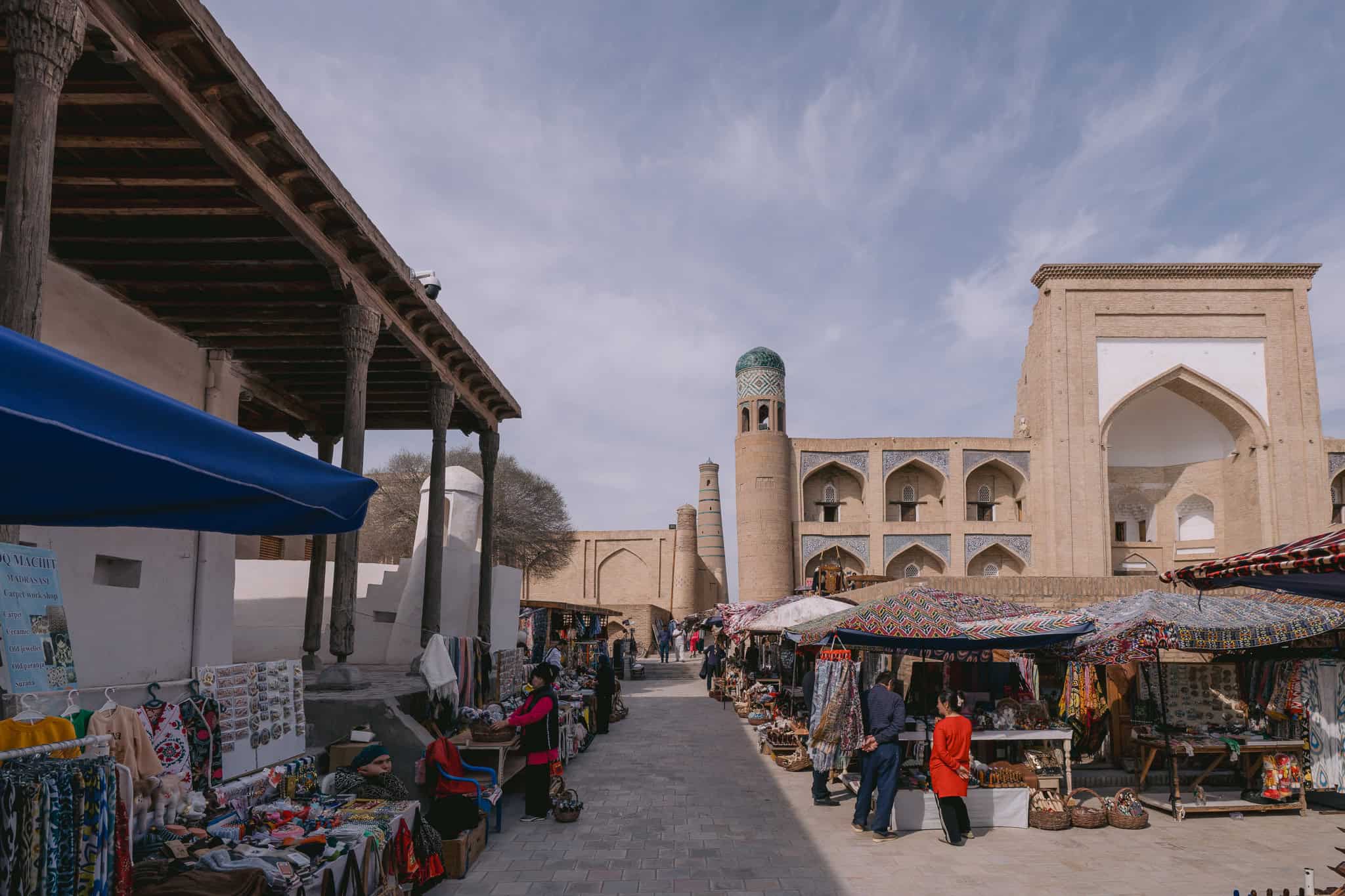
Khiva is out of the way and takes planning and effort to get to, which is why so many travelers skip it.
But I think it’s worth the detour.
Khiva ended up being one of my favorite cities on my mother–son trip to Uzbekistan. In fact, my son still talks about it today! It’s the perfect blend of well-preserved Silk Road architecture and fascinating Central Asian history, with plenty of ancient sites to check out (or not — it’s perfectly fine to meander through Itchan Kala’s walled streets and not go into any of the buildings, too). And it’s photogenic to boot.
If that sounds intriguing to you, Khiva, Uzbekistan needs to be on your Silk Road itinerary.

